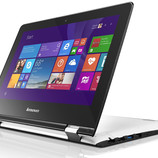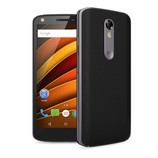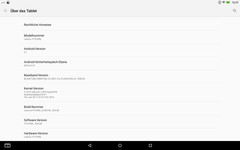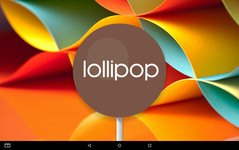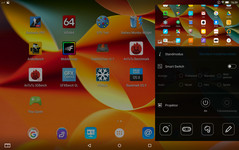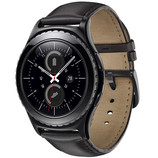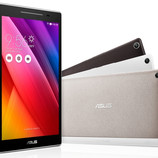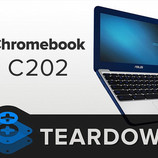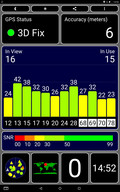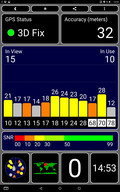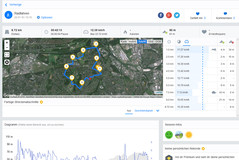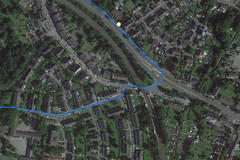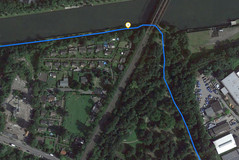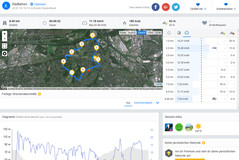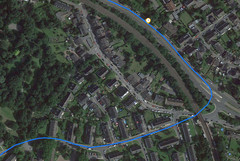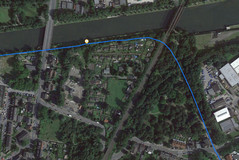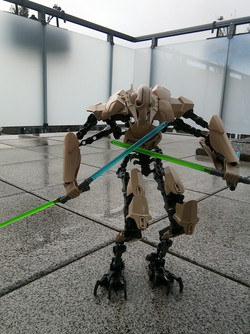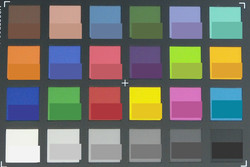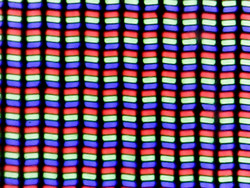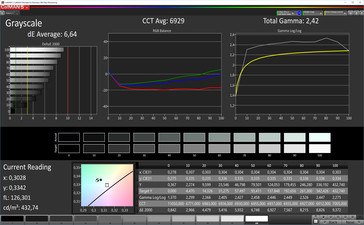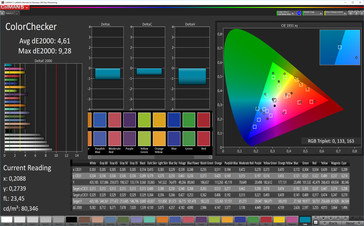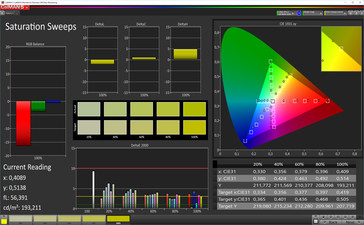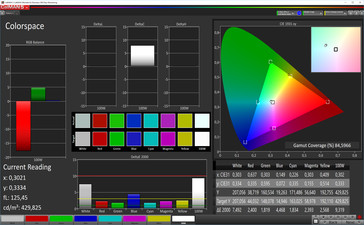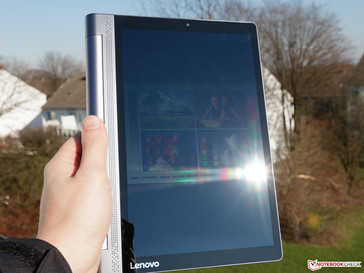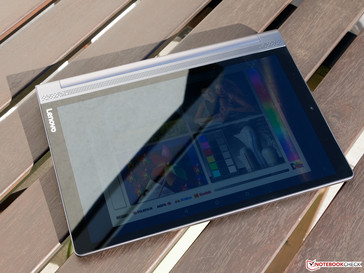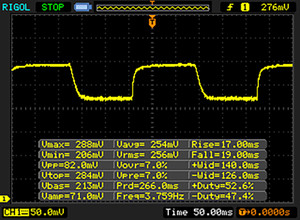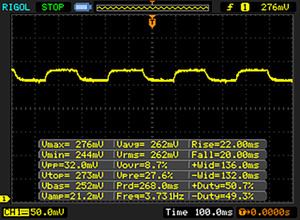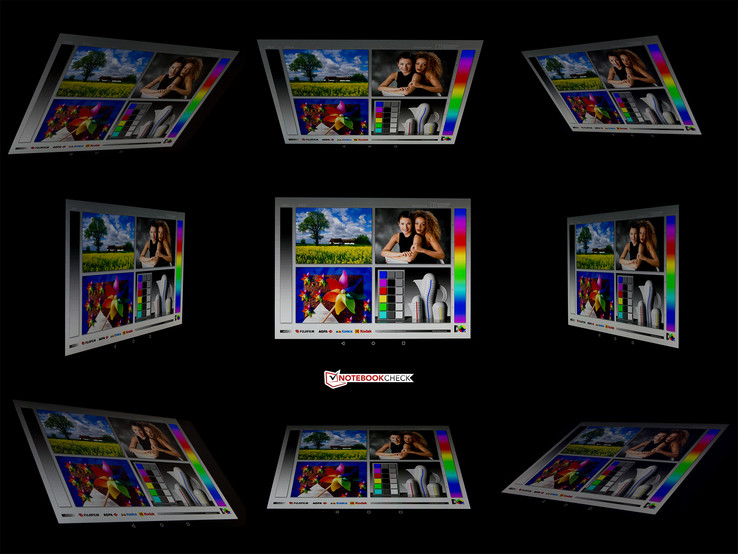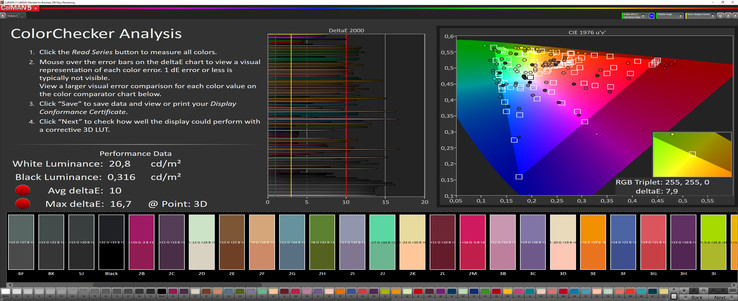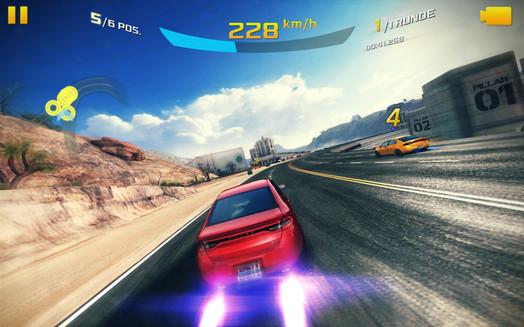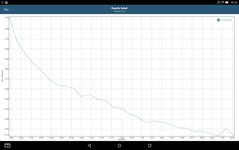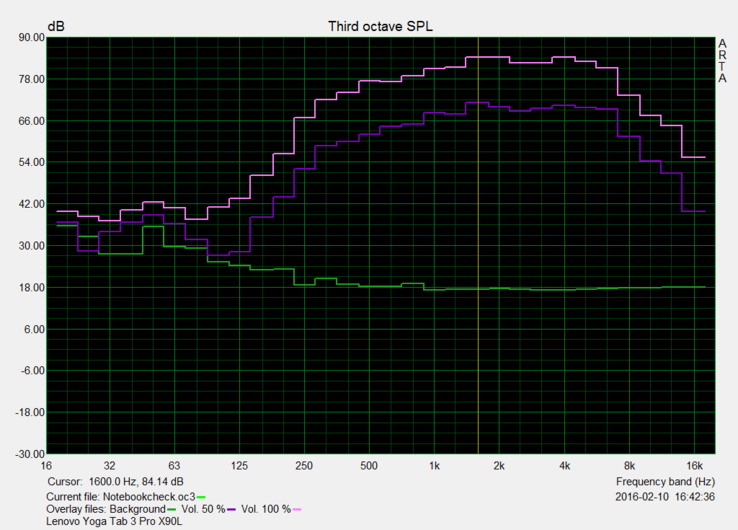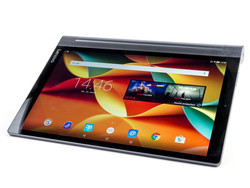Well-conceived. The Pro version of Lenovo's 10-inch Yoga tablet is in a completely different price range than its smaller members. This is also noticed in all areas, starting with the casing over the screen, the integrated projector - even the accessories are higher quality. Moreover, the good battery life makes the device a really decent tablet.
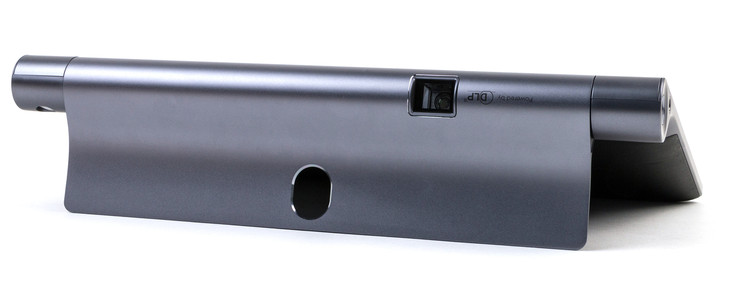
Test device courtesy of notebooksbilliger.de
See our Top 10 Notebooks:
» Multimedia, » Gaming, » Lightweight Gaming
» Budget Office, » Business, » Workstations
» Subnotebooks, » Utrabooks, » Convertibles
» Budget Office, » Business, » Workstations
» Subnotebooks, » Utrabooks, » Convertibles
» Top 10 under 300 Euros, » under 500 Euros
» Best Notebooks for University Students
» Top Windows alternatives to Apple's MacBook series
» Best Notebook Displays
» Best Notebooks for University Students
» Top Windows alternatives to Apple's MacBook series
» Best Notebook Displays
Top 10 Tablets / Smartphones:
Case
Compared with its rivals, Lenovo's Yoga Tab 3 Pro 10 is quite heavy. However, its casing is made entirely of plastic with an attractive metal look. The back features a soft leather cover that enhances the grip and looks good at the same time. Only the kickstand is metal, and makes a very robust impression.
The tablet's kickstand enables using the device in four different modes. It closes absolutely flush with the casing when folded in, and the Yoga-typical bulge makes it comfortable to hold. The kickstand is unlocked by pressing a button. It can then be placed in Tilt Mode, which is perfect for using the projector. The device can be set up at 90 degrees in Stand Mode. It is even possible to hang up the tablet as an alternative.
The manufacturer cheats a little about the height and apparently states the lowest height in the technical specs (4.68 mm/~0.18 in). We measured 10.15 millimeters (~0.4 in) at the screen's center edge and 22 millimeters (~0.86 in) at the cylinder bulge. The build makes a good impression. Although the tablet can be warped slightly and produces quiet cracking noises, the device is insensitive to pressure. The gaps are also beyond reproach.
The card slot's flap under the kickstand does not make a long-lasting impression. Only two thin plastic hooks, which look very fragile, keep it in place. A micro-SD and micro-SIM card can be inserted or ejected comfortably from the spring-loaded slot.
Connectivity
Software
Communication & GPS
Lenovo's Yoga Tab 3 Pro 10 connects to the Internet via an integrated WWAN modem on the go. It supports HSPA+ (max. 42 MBit/s) and LTE Cat. 4 (max. 150 MBit/s). Both connection standards feature a wide frequency coverage so that connections should be possible worldwide. The reception using the German O2 network in an urban center was inconspicuous.
The tablet's configuration for Wi-Fi at home is appropriate for the price. It supports the IEEE 802.11 a/b/g/n/ac standards, and can thus use both 2.4 and 5.0 GHz networks. The module's range is good and does not give any reason for complaint. The reception was good, even at 10 meters (~33 ft) away from the router (Fritz!Box 6360) and through two walls, while streaming HD videos was easily possible.
Cameras
Discussion
Sharpness & Color Accuracy
Accessories
The accessories included with the Yoga Tab 3 Pro are not very extensive and limited to a USB data cable and modular power supply. The latter has a nominal output of 10.4 watts (5.2 volts, 2.0 ampere), and is TÜV certified (German technical inspection agency) and GS safety tested.
Lenovo offers optional sleeves that were not sold in the shop at the time of testing.
Warranty
Lenovo includes a 12-month warranty on its product. The additional two year dealer warranty applies for private customers. It is also possible to extend the warranty up to three years for an extra charge. Prices can be requested from Lenovo.
Input Devices & Handling
Display
| |||||||||||||||||||||||||
X-Rite i1Pro 2
Maximum: 484 cd/m² Average: 434.1 cd/m² Minimum: 5.95 cd/m²Brightness Distribution: 82 %
Center on Battery: 429 cd/m²
Contrast: 1226:1 (Black: 0.35 cd/m²)
ΔE Color 4.61 | 1.01-23.34 Ø6.8
ΔE Greyscale 6.64 | 0.79-16.8 Ø7.1
Gamma: 2.42
| Lenovo Yoga Tab 3 Pro 10 YT3-X90L HD Graphics (Cherry Trail), Z8500, 32 GB eMMC Flash | Lenovo Yoga Tab 3 YT3-X50F Adreno 304, 212 APQ8009, 16 GB eMMC Flash | Amazon Fire HD 10 inch 2015 PowerVR G6200, MT8135, 16 GB eMMC Flash | Apple iPad Air 2 PowerVR GXA6850, A8X, 128 GB eMMC Flash | Samsung Galaxy Tab S2 9.7 LTE Mali-T760 MP6, 5433 Octa, 32 GB eMMC Flash | Google Pixel C Tegra X1 Maxwell GPU, X1, 64 GB eMMC Flash | |
|---|---|---|---|---|---|---|
| Screen |
13%
|
2%
|
-3%
|
41%
|
-6%
| |
| Brightness Center | 429 | 363
-15%
| 458
7%
| 423
-1%
| 358
-17%
| 487
14%
|
| Black Level * | 0.35 | 0.34
3%
| 0.43
-23%
| 0.61
-74%
| 0.39
-11%
| |
| Contrast | 1226 | 1068
-13%
| 1065
-13%
| 693
-43%
| 1249
2%
| |
| Colorchecker DeltaE2000 * | 4.61 | 3.25
30%
| 4.18
9%
| 2.86
38%
| 1.78
61%
| 5.24
-14%
|
| Greyscale DeltaE2000 * | 6.64 | 2.78
58%
| 4.54
32%
| 2.37
64%
| 1.38
79%
| 7.95
-20%
|
| Gamma * | 2.42 | 2.23 | 2.15 | 2.43 | 2.24 | 2.16 |
| Color Space (Percent of AdobeRGB 1998) | 88 | 98 |
* ... smaller is better
Display Response Times
| ↔ Response Time Black to White | ||
|---|---|---|
| 36 ms ... rise ↗ and fall ↘ combined | ↗ 17 ms rise | |
| ↘ 19 ms fall | ||
| The screen shows slow response rates in our tests and will be unsatisfactory for gamers. In comparison, all tested devices range from 0.8 (minimum) to 240 (maximum) ms. » 87 % of all devices are better. This means that the measured response time is worse than the average of all tested devices (29.2 ms). | ||
| ↔ Response Time 50% Grey to 80% Grey | ||
| 42 ms ... rise ↗ and fall ↘ combined | ↗ 22 ms rise | |
| ↘ 20 ms fall | ||
| The screen shows slow response rates in our tests and will be unsatisfactory for gamers. In comparison, all tested devices range from 0.9 (minimum) to 92 (maximum) ms. » 42 % of all devices are better. This means that the measured response time is similar to the average of all tested devices (42.7 ms). | ||
Projector
Performance
Lenovo relies on an Intel Atom x5-Z8500 SoC for its premium Android tablet. The quad-core processor clocks at 1.44 to 2.24 GHz, and can definitely compete with a Snapdragon 810 in terms of CPU performance. Unfortunately, this is not true for the integrated Intel HD Graphics (Cherry Trail) graphics unit. Nevertheless, the powerful bundle provides fast performance for routine use and the system runs smoothly. The 2 GB of LPDDR3 working memory could have been slightly more generous.
These expectations are not quite reflected in the benchmarks. Geekbench is known for not supporting all APIs of x86 CPUs, and thus they cannot develop their full performance in this benchmark. However, the SoC also lags behind its potential in the 3DMark Physic test, as the direct comparison with Xiaomi's MiPad 2 based on the same chipset illustrates. This quite possibly points to throttling.
Geekbench 3 | 3DMark (2013) | GFXBench 3.0 | PCMark for Android | BaseMark OS II | AnTuTu Benchmark v6
| Geekbench 3 | |
| 64 Bit Single-Core Score (sort by value) | |
| Lenovo Yoga Tab 3 Pro 10 YT3-X90L | |
| Apple iPad Air 2 | |
| Samsung Galaxy Tab S2 9.7 LTE | |
| Google Pixel C | |
| Xiaomi MiPad 2 | |
| 64 Bit Multi-Core Score (sort by value) | |
| Lenovo Yoga Tab 3 Pro 10 YT3-X90L | |
| Apple iPad Air 2 | |
| Samsung Galaxy Tab S2 9.7 LTE | |
| Google Pixel C | |
| Xiaomi MiPad 2 | |
Subjectively, the browser performance using Google's preloaded Chrome browser is very good and does not give any reason for complaint. Lenovo's Yoga Tab 3 Pro 10 also delivers a good performance in the benchmarks, and is only defeated by the iPad Air 2 in Octane 2.0 and Mozilla Kraken.
| JetStream 1.1 - 1.1 Total Score (sort by value) | |
| Lenovo Yoga Tab 3 Pro 10 YT3-X90L (Chrome 48) | |
| Lenovo Yoga Tab 3 YT3-X50F (Chrome 48.0.2564.95) | |
| Samsung Galaxy Tab S2 9.7 LTE (Chrome 45) | |
| Google Pixel C (Chrome 44.0.2403.133) | |
| Xiaomi MiPad 2 (Chrome 48) | |
* ... smaller is better
Actually, the rather mediocre storage performance is enough for a place in the upper third performance section in the comparison field. The user will not even have 22 GB of the 32 GB internal flash memory available after the initial start. The preloaded product video and proprietary apps reserve approximately 1.7 GB.
A micro-SD card can expand the storage quickly and affordably should the internal storage get tight. We tested the card slot's performance with our Toshiba Exceria SD-CX32UHS1 reference card (max. read: 95 MB/s; write: 60 MB/s). The rates the tablet achieves are rather weak (read: 56.41 MB/s; write: 15.93 MB/s), but should be enough for most application scenarios.
| AndroBench 3 | |
| Sequential Read 256KB (sort by value) | |
| Lenovo Yoga Tab 3 Pro 10 YT3-X90L | |
| Lenovo Yoga Tab 3 YT3-X50F | |
| Amazon Fire HD 10 inch 2015 | |
| Samsung Galaxy Tab S2 9.7 LTE | |
| Google Pixel C | |
| Xiaomi MiPad 2 | |
| Sequential Write 256KB (sort by value) | |
| Lenovo Yoga Tab 3 Pro 10 YT3-X90L | |
| Lenovo Yoga Tab 3 YT3-X50F | |
| Amazon Fire HD 10 inch 2015 | |
| Samsung Galaxy Tab S2 9.7 LTE | |
| Google Pixel C | |
| Xiaomi MiPad 2 | |
| Random Read 4KB (sort by value) | |
| Lenovo Yoga Tab 3 Pro 10 YT3-X90L | |
| Lenovo Yoga Tab 3 YT3-X50F | |
| Amazon Fire HD 10 inch 2015 | |
| Samsung Galaxy Tab S2 9.7 LTE | |
| Google Pixel C | |
| Xiaomi MiPad 2 | |
| Random Write 4KB (sort by value) | |
| Lenovo Yoga Tab 3 Pro 10 YT3-X90L | |
| Lenovo Yoga Tab 3 YT3-X50F | |
| Amazon Fire HD 10 inch 2015 | |
| Samsung Galaxy Tab S2 9.7 LTE | |
| Google Pixel C | |
| Xiaomi MiPad 2 | |
| Sequential Read 256KB SDCard (sort by value) | |
| Lenovo Yoga Tab 3 Pro 10 YT3-X90L (Toshiba Exceria SD-CX32UHS1) | |
| Sequential Write 256KB SDCard (sort by value) | |
| Lenovo Yoga Tab 3 Pro 10 YT3-X90L (Toshiba Exceria SD-CX32UHS1) | |
Games
| Asphalt 8: Airborne | |||
| Settings | Value | ||
| high | 47 fps | ||
| very low | 58 fps | ||
| Temple Run 2 | |||
| Settings | Value | ||
| default | 34 fps | ||
Emissions
Speakers
Energy Management
Power Consumption
While the standby and shut down power consumption of Lenovo's Yoga Tab 3 Pro cannot be reproached, it is quite high when in use. This applies to both idle and load states. However, the energy requirement should be much lower particularly in idle mode. All rivals consume less than half the power here.
Power Consumption
| Off / Standby | |
| Idle | |
| Load | |
| Key: min: | |
Battery Runtime
In contrast to what the power consumption measurements suggest, Lenovo's Yoga Tab 3 Pro 10 achieves very good battery runtimes. This is probably due to its high-capacity 6600 mAh battery.
The manufacturer promises a battery life of up to 18 hours. However, we only managed this in the Reader's test where the review sample ran at minimum brightness (5.95 cd/m²) in our tests. The tablet is convincing in the comparison field, and is only defeated by its much weaker sister modeland Google Pixel C.
We tested video playback using the projector. Here, we rendered the same "Big Buck Bunny" video at maximum brightness under identical conditions as we use for our standard video test. Since the maximum power consumption is 7.68 watts in that case, the runtimes in projector mode should be slightly higher than when playing the video directly on the tablet.
Battery Runtime
| Idle (without WLAN, min brightness) |
| 21h 01min |
| WiFi Surfing v1.3 |
| 9h 18min |
| Big Buck Bunny H.264 1080p |
| 10h 44min |
| Load (maximum brightness) |
| 5h 23min |
| Lenovo Yoga Tab 3 Pro 10 YT3-X90L HD Graphics (Cherry Trail), Z8500, 32 GB eMMC Flash | Lenovo Yoga Tab 3 YT3-X50F Adreno 304, 212 APQ8009, 16 GB eMMC Flash | Amazon Fire HD 10 inch 2015 PowerVR G6200, MT8135, 16 GB eMMC Flash | Apple iPad Air 2 PowerVR GXA6850, A8X, 128 GB eMMC Flash | Samsung Galaxy Tab S2 9.7 LTE Mali-T760 MP6, 5433 Octa, 32 GB eMMC Flash | Google Pixel C Tegra X1 Maxwell GPU, X1, 64 GB eMMC Flash | |
|---|---|---|---|---|---|---|
| Battery Runtime |
52%
|
-18%
|
-13%
|
-17%
|
22%
| |
| Reader / Idle | 1261 | 2830
124%
| 1142
-9%
| 1364
8%
| 918
-27%
| 2090
66%
|
| Load | 323 | 415
28%
| 188
-42%
| 212
-34%
| 291
-10%
| 294
-9%
|
| WiFi v1.3 | 558 | 776
39%
| 450
-19%
| 393
-30%
| 638
14%
| |
| H.264 | 644 | 740
15%
| 624
-3%
| 562
-13%
| 651
1%
| 740
15%
|
| WiFi | 630 |
Verdict
Lenovo Yoga Tab 3 Pro 10 YT3-X90L - 03/16/2016 v5
Daniel Schmidt
Daniel Schmidt
Tablet - Weighted Average
















